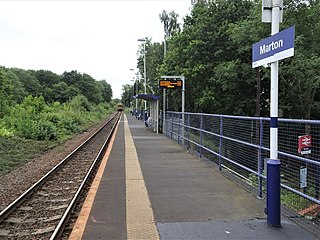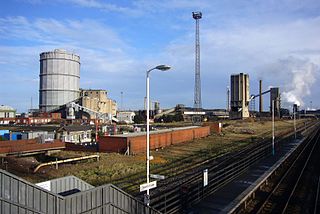
Middlesbrough is a town in the Middlesbrough unitary authority borough of North Yorkshire, England. The town lies near the mouth of the River Tees and north of the North York Moors National Park. The built-up area had a population of 148,215 at the 2021 UK census. It is the largest town of the wider urban Tees Valley area, which had a population of 678,400 in 2021.

Teesside is a built-up area around the River Tees in North East England, split between County Durham and North Yorkshire. The area contains the towns of Middlesbrough, Stockton-on-Tees, Billingham, Redcar, Thornaby-on-Tees, and Ingleby Barwick. Teesside's economy was once dominated by heavy manufacturing until deindustrialisation in the latter half of the 20th century. Chemical production continues to contribute significantly to Teesside's economy.

Thornaby-on-Tees, commonly referred to as Thornaby, is a town and civil parish on the River Tees's southern bank. It is in the Borough of Stockton-on-Tees, North Yorkshire, England. The parish had a population of 24,741 at the 2011 census, in the Teesside built-up area.

The Borough of Stockton-on-Tees is a unitary authority with borough status in the counties of County Durham and North Yorkshire, England. The borough had a population of 196,600 in 2021.

Tees Valley is a combined authority area in Northern England, around the lower River Tees. The area is not a geographical valley; the local term for the valley is Teesdale. The combined authority covers five council areas: Darlington, Hartlepool, Middlesbrough, Redcar and Cleveland and Stockton-on-Tees.

The Esk Valley Line is a railway line located in the north of England, covering a total distance of approximately 35 miles (56 km), running from Middlesbrough to Whitby. The line follows the course of the River Esk for much of its eastern half.

The Durham Coast Line is an approximately 39.5-mile (63.6 km) railway line running between Newcastle and Middlesbrough in North East England. Heavy rail passenger services, predominantly operated Northern Trains, and some freight services operate over the whole length of the line; it provides an important diversionary route at times when the East Coast Main Line is closed. Light rail services of the Tyne and Wear Metro's Green Line also operate over the same tracks between a junction just south of Sunderland station and Pelaw Junction.

Darlington railway station is on the East Coast Main Line serving the town of Darlington in County Durham, England. It is 232 miles 50 chains north of London King's Cross. It is situated between Northallerton to the south and Durham to the north. Its three-letter station code is DAR.

The Tees Valley Line is a rail route, in Northern England, following part of the original Stockton and Darlington Railway route of 1825. The line covers a distance of 38 miles (61 km), and connects Bishop Auckland to Saltburn via Darlington, Middlesbrough and 14 other stations in the Teesdale.

Thornaby is a railway station on the Tees Valley Line, which runs between Bishop Auckland and Saltburn via Darlington. The station, situated 3 miles 17 chains (5.2 km) south-west of Middlesbrough, serves the market town of Thornaby-on-Tees, Borough of Stockton-on-Tees in North Yorkshire, England. It is owned by Network Rail and managed by TransPennine Express.

Middlesbrough is a railway station on the Durham Coast Line, Esk Valley Line and Tees Valley Line. The station serves the town of Middlesbrough in North Yorkshire, England. It is owned by Network Rail and managed by TransPennine Express. Direct destinations include Darlington, Saltburn, Sunderland, Newcastle, York, and Manchester Airport. There is a direct service to London Kings Cross once per weekday.

Billingham is a railway station on the Durham Coast Line, which runs between Newcastle and Middlesbrough via Hartlepool. The station, situated 10 miles 8 chains (16.3 km) north-west of Middlesbrough, serves the town of Billingham, Borough of Stockton-on-Tees in County Durham, England. It is owned by Network Rail and managed by Northern Trains.

Marton is a railway station on the Esk Valley Line, which runs between Middlesbrough and Whitby via Nunthorpe. The station, situated 2 miles 79 chains (4.8 km) south-east of Middlesbrough, serves the suburbs of Marton, Middlesbrough and Ormesby, Redcar and Cleveland in North Yorkshire, England. It is owned by Network Rail and managed by Northern Trains.

Teesside Airport railway station is on the Tees Valley line which runs between Bishop Auckland and Saltburn via Darlington in County Durham, England. The station is 5.5 miles (9 km) east of Darlington and about 1 mile (1.6 km) from Teesside International Airport, which owns the station. It is managed by Northern Trains, which also operated the limited service calling at the station prior to its temporary closure in 2022.

South Bank is a railway station on the Tees Valley Line, which runs between Bishop Auckland and Saltburn via Darlington. The station, situated 2 miles 40 chains (4.0 km) east of Middlesbrough, serves the town of South Bank, Redcar and Cleveland in North Yorkshire, England. It is owned by Network Rail and managed by Northern Trains.
Tees Valley Regeneration was an urban regeneration company covering the Tees Valley area of North East England and at one time was the largest urban development agency in England. The headquarters were at Cavendish House, Teesdale Business Park in Thornaby-on-Tees.

The County Borough of Teesside was a county borough in the north-east of England, which existed for just six years. It was created in 1968 to cover the Teesside conurbation which had grown up around the various port and industrial towns near the mouth of the River Tees. The council was based in Middlesbrough, the area's largest town. The county borough was abolished in 1974 on the creation of the new county of Cleveland, which covered a larger area, with the county borough's territory being split between three of the four districts created in the new county.

James Cook is a railway station on the Esk Valley Line, which runs between Middlesbrough and Whitby via Nunthorpe. The station, situated 2 miles 24 chains (3.7 km) south-east of Middlesbrough, serves James Cook University Hospital and the suburbs of Berwick Hills and Park End, Middlesbrough in North Yorkshire, England. It is owned by Network Rail and managed by Northern Trains.
Roseberry Parkway railway station is a proposed railway station which would be between Nunthorpe and Great Ayton railway stations on the Esk Valley Line, in North Yorkshire, England. The station was proposed in August 2019 by a joint project between Redcar & Cleveland and Middlesbrough Councils and the Tees Valley Combined Authority. The project is "aimed at easing road congestion and improving access to East Cleveland".
The non-metropolitan county of Cleveland was created under the Local Government Act 1972, which came into effect on 1 April 1974, comprising the urban areas around the mouth of the River Tees, previously parts of the administrative counties of Durham and North Riding of Yorkshire. Although it was abolished in 1996, the four unitary authorities which succeeded it have been considered together for the purposes of reviewing parliamentary boundaries. The area has returned 6 MPs to the UK Parliament since 1983.


















